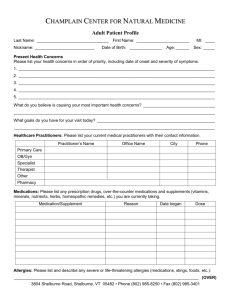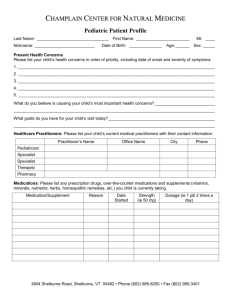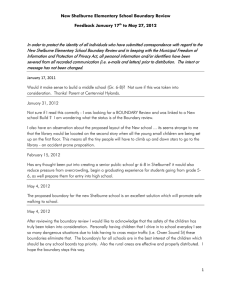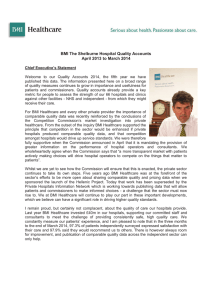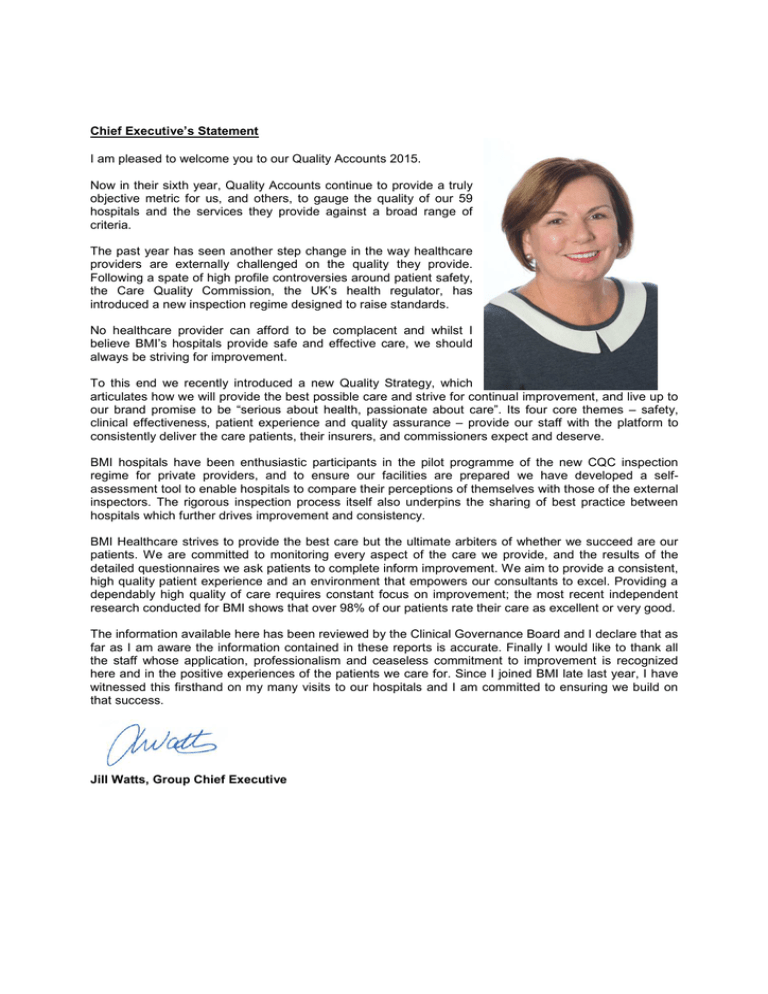
Chief Executive’s Statement
I am pleased to welcome you to our Quality Accounts 2015.
Now in their sixth year, Quality Accounts continue to provide a truly
objective metric for us, and others, to gauge the quality of our 59
hospitals and the services they provide against a broad range of
criteria.
The past year has seen another step change in the way healthcare
providers are externally challenged on the quality they provide.
Following a spate of high profile controversies around patient safety,
the Care Quality Commission, the UK’s health regulator, has
introduced a new inspection regime designed to raise standards.
No healthcare provider can afford to be complacent and whilst I
believe BMI’s hospitals provide safe and effective care, we should
always be striving for improvement.
To this end we recently introduced a new Quality Strategy, which
articulates how we will provide the best possible care and strive for continual improvement, and live up to
our brand promise to be “serious about health, passionate about care”. Its four core themes – safety,
clinical effectiveness, patient experience and quality assurance – provide our staff with the platform to
consistently deliver the care patients, their insurers, and commissioners expect and deserve.
BMI hospitals have been enthusiastic participants in the pilot programme of the new CQC inspection
regime for private providers, and to ensure our facilities are prepared we have developed a selfassessment tool to enable hospitals to compare their perceptions of themselves with those of the external
inspectors. The rigorous inspection process itself also underpins the sharing of best practice between
hospitals which further drives improvement and consistency.
BMI Healthcare strives to provide the best care but the ultimate arbiters of whether we succeed are our
patients. We are committed to monitoring every aspect of the care we provide, and the results of the
detailed questionnaires we ask patients to complete inform improvement. We aim to provide a consistent,
high quality patient experience and an environment that empowers our consultants to excel. Providing a
dependably high quality of care requires constant focus on improvement; the most recent independent
research conducted for BMI shows that over 98% of our patients rate their care as excellent or very good.
The information available here has been reviewed by the Clinical Governance Board and I declare that as
far as I am aware the information contained in these reports is accurate. Finally I would like to thank all
the staff whose application, professionalism and ceaseless commitment to improvement is recognized
here and in the positive experiences of the patients we care for. Since I joined BMI late last year, I have
witnessed this firsthand on my many visits to our hospitals and I am committed to ensuring we build on
that success.
Jill Watts, Group Chief Executive
Hospital Information
BMI The Shelburne Hospital
The Shelburne Hospital has 29 Beds with the majority offering the privacy and comfort of ensuite
facilities, satellite television and telephones. The Hospital also boasts three Theatres. There is also a High
Dependency unit, Radiology and Physiotherapy departments and 5 consulting suites. These facilities
combined with the latest technology and on-site support enable out Consultants to undertake a wide
range of procedures from routine investigations to complex surgery.
During 2014-2015 25% of the activity in BMI The Shelburne Hospital was NHS work. The top ten
procedures, which include hip and knee replacements, joint injections and knee arthroscopies, make up
50% of the work throughout the year.
BMI Healthcare are registered as a provider with the Care Quality Commission (CQC) under the
Health & Social Care Act 2008. BMI The Shelburne Hospital is registered as a location for the
following regulated services:•
•
•
•
Treatment of disease, disorder and injury
Surgical procedures
Diagnostic and screening
Family Planning
The CQC carried out an unannounced inspection on 19th March 2014 and found that the
Hospital to be fully compliant.
Standards of treating people with respect and involving them in their care
Standards of providing care, treatment & support which meets people's needs
Standards of caring for people safely & protecting them from harm
Standards of staffing
Standards of management
The Shelburne Hospital has a local framework through which clinical effectiveness, clinical
incidents and clinical quality is monitored and analysed. Where appropriate, action is taken to
continuously improve the quality of care. This is through the work of a multidisciplinary group
and the Medical Advisory Committee.
Regional Clinical Quality Assurance Groups monitor and analyse trends and ensure that the
quality improvements are operationalised. There has been development of
At corporate level the Clinical Governance Board has an overview and provides the strategic
leadership for corporate learning and quality improvement.
There has been ongoing focus on robust reporting of all incidents, near misses and outcomes.
Data quality has been improved by ongoing training and database improvements. New reporting
modules have increased the speed at which reports are available and the range of fields for
analysis. This ensures the availability of information for effective clinical governance with
implementation of appropriate actions to prevent recurrences in order to improve quality and
safety for patients, visitors and staff.
At present we provide full, standardised information to the NHS, including coding of procedures,
diagnoses and co-morbidities and PROMs for NHS patients.There are additional external
reporting requirements for CQC, Public Health England (Previously HPA) CCGs and Insurers
BMI is a founding member of the Private Healthcare Information Network (PHIN) UK – where
we produce a data set of all patient episodes approaching HES-equivalency and submit this to
PHIN for publication. The data is made available to common standards for inclusion in
comparative metrics, and is published on the PHIN website http://www.phin.org.uk. This website
gives patients information to help them choose or find out more about an independent hospital
including the ability to search by location and procedure.
1. Safety
1.1 Infection prevention and control
The focus on infection prevention and control continues under
the leadership of the Group Head of Infection Prevention and
Control, in liaison with the link nurse in The Shelburne Hospital
The focus on infection prevention and control continues under
the leadership of the Group Director of Infection Prevention and
Control and Group Head of Infection Prevention and Control, in
liaison with the Infection Prevention and Control Lead The
Shelburne Hospital.
We have had: • Zero number of MRSA bacteremia cases/100,000 bed
days
• Zero number of MSSA bacteremia cases /100,000 bed
days
• Zero number of E.coli bacteremia cases/ 100,000 bed days
• Zero number of hospital apportioned Clostridium difficile in the last 12 months.
• SSI data is also collected and submitted to Public Health England for Orthopaedic
surgical procedures. Our rates of infection are;
o Hips – 1 Superficial surgical site infection
o Knees – 0 Superficial surgical site infection
The hospital has undertaken audits across a number of different areas, specifically focusing on:
• Hand hygiene (Please see results from audit below)
• Environmental.
Environmental cleanliness is also an important factor in infection prevention and our patients
rate the cleanliness of our facilities highly.
1.2 Patient Led Assessment of the Care Environment (PLACE)
We believe a patient should be cared for with compassion and dignity in a clean, safe environment.
Where standards fall short, they should be able to draw it to the attention of managers and hold the
service to account. PLACE assessments will provide motivation for improvement by providing a clear
message, directly from patients, about how the environment or services might be enhanced.
In 2013 we introduced PLACE, which is the new system for assessing the quality of the patient
environment, replacing the old Patient Environment Action Team (PEAT) inspections.
The assessments involve patients and staff who assess the hospital and how the environment
supports patient’s privacy and dignity, food, cleanliness and general building maintenance. It focuses
entirely on the care environment and does not cover clinical care provision or how well staff are
doing their job.
The results will show how hospitals are performing nationally and locally. Results of the hospital areCleanliness
97.22%
Food
93.19%
Privacy, Dignity and Wellbeing
84.00%
Facilities
95.14%
1.3 Venous Thrombo-embolism (VTE)
BMI Healthcare, holds VTE Exemplar Centre status by the Department of Health across its
whole network of hospitals including, The Shelburne Hospital BMI Healthcare was awarded the
Best VTE Education Initiative Award category by Lifeblood in February 2013 and were the
Runners up in the Best VTE Patient Information category.
We see this as an important initiative to further assure patient safety and care. We audit our
compliance with our requirement to VTE risk assessment every patient who is admitted to our
facility and the results of our audit on this has shown us to be 100% compliant. This
demonstrates that the systems in place for risk assessing patients are robust. Monitoring and
audit of this process will be maintained.
The Shelburne Hospital reports the incidence of Venous Thromboembolism (VTE) through the
corporate clinical incident system. It is acknowledged that the challenge is receiving information
for patients who may return to their GPs or other hospitals for diagnosis and/or treatment of VTE
post discharge from the Hospital. As such we may not be made aware of them. We continue to
work with our Consultants and referrers in order to ensure that we have as much data as
possible.
2. Effectiveness
2.1 Patient reported Outcomes (PROMS)
Patient Reported Outcome Measures (PROMs) are a means of collecting information on the
effectiveness of care delivered to NHS patients as perceived by the patients themselves.
PROMs is a Department of Health led programme.
Latest results can be found by going on the online SOLAR system provided to you by Quality
Health
For the current reporting period, the tables below demonstrate that the health gain between
Questionnaire 1 (pre-operative) and Questionnaire 2 (post–operative) for patients undergoing
hip replacement and knee replacement at The Shelburne Hospital.
April 14 – September 14
Oxford Hip Score average
Health gain between reporting
Q1
Q2
periods
The Shelburne Hospital
15.05
37.167
21.667
England
18.16
40.081
21.922
Copyright © 2013, The Health and Social Care Information Centre. All Rights Reserved.
April 14 – September 14
Oxford Knee Score average
Health gain between reporting
Q1
Q2
periods
The Shelburne Hospital
England
*
*
* less than 30 patients went through this
pathway during the time period in question as a result, no score has been provided
19.401
36.103
16.702
Copyright © 2013, The Health and Social Care Information Centre. All Rights Reserved.
2.2 Enhanced Recovery Programme (ERP)
The ERP is about improving patient outcomes and speeding up a patient’s recovery after
surgery. ERP focuses on making sure patients are active participants in their own recovery and
always receive evidence based care at the right time. It is often referred to as rapid recovery, is
a new, evidence-based model of care that creates fitter patients who recover faster from major
surgery. It is the modern way for treating patients where day surgery is not appropriate.
ERP is based on the following principles:1. All Patients are on a pathway of care
a. Following best practice models of evidenced based care
b. Reduced length of stay
2. Patient Preparation
a. Pre Admission assessment undertaken
b. Group Education sessions
c. Optimizing the patient prior to admission – i.e HB optimisation, control comorbidities, medication assessment – stopping medication plan.
d. Commencement of discharge planning
3. Proactive patient management
a. Maintaining good pre-operative hydration
b. Minimising the risk of post-operative nausea and vomiting
c. Maintaining normothermia pre and post operatively
d. Early mobilisation
4. Encouraging patients have an active role in their recovery
a. Participate in the decision making process prior to surgery
b. Education of patient and family
c. Setting own goals daily
d. Participate in their discharge planning
At BMI the Shelburne Hospital we have monthly ERP meetings to ensure we are implementing the best
practice principles of ERP. At Pre-op assessment all patients are informed of the length of stay that can
be expected. We have introduced carbohydrate loading which assists with their post-operative recovery.
We are currently in the process of developing a joint school.
2.3 Unplanned Readmissions within 31 days and unplanned returns to theatre.
Unplanned readmissions and unplanned returns to theatre are normally due to a clinical
complication related to the original surgery.
3. Patient experience
3.1 Patient satisfaction
BMI Healthcare is committed to providing the highest levels of quality of care to all of our
patients. We continually monitor how we are performing by asking patients to complete a patient
satisfaction questionnaire. Patient satisfaction surveys are administered by an independent third
party.
3.2 Complaints
In addition to providing all patients with an opportunity to complete a satisfaction survey BMI
The Shelburne Hospital actively encourages feedback both informally and formally. Patients are
supported through a robust complaints procedure, operated over three stages:
Stage 1: Hospital resolution
Stage 2: Corporate resolution
Stage 3: Patients can refer their complaint to independent adjudication if they are not satisfied
with the outcome at the other 2 stages.
4. CQUINS
5. Agreed CQUINS for 2014-2015 are as follows
INDICATORS
Quarter 1
Quarter 2
Quarter 3
Quarter 4
22.65%
34.15%
56.32%
51.96%
Yes
Yes
Yes
Yes
VTE Risk Assessment
% of adult inpatients reported as having had a VTE
risk assessment on admission to Hospital using the
clinical criteria of the national tool
100%
100%
100%
100%
VTE Root Cause Analysis
Number of RCAs on confirmed cases of pulmonary
embolism or deep vein thrombosis whilst an
inpatient.
% of cases of hospital associated thrombosis
where a root cause analysis has been carried out.
0
100%
0
100%
0
100%
0
100%
Surgical Care Bundle Audits: Catheters:
Completion of monthly audits
Number of patient records audited capturing
surgical care bundles per month .
30
30
30
30
Post-surgical remote follow up: increased
number of patients followed up remotely
Number of patients receiving post-surgical
telephone calls
Number of records audited in month(minimum
10)
30
30
30
30
30
30
30
30
Lifestyle interventions: indentification of patients
with BMI>30
Number of patient records audited with
completion risk assessment for weight associated
health issue per month.
Number of records audited in month (minimum of
10)
30
30
30
30
30
30
30
30
Friends & Family Test
FFT increased response rate
NHS Safety Thermometer
Safety thermometer survery data for all
appropriate patients, settings for relevant
measures submitted.
5. National Clinical Audits
The Shelburne Hospital was only eligible to participate in National Joint Registry audit and all
joint replacements are submitted to this. BMI hospital data is from page 196 onwards in
attached latest NJS report. Use this if appropriate with your narrative on the data and any
improvement plans.
6. Research
No NHS patients were recruited to take part in research.
7. Priorities for service development and improvement
•
•
•
•
Increasing Outpatient services
Increase complexity of surgical cases
Revise separate governance process with separate managers
Rolling replacement programme to replace flooring on all wards.
8. Mandatory Quality Indicators
8.1 The value of the summary hospital-level mortality indicator for the Shelburne Hospital for the
reporting period.
Unit
0
Reporting Periods
(at least last two
reporting periods)
Oct 2012 – Jun 2014
National
Average
Highest National
Score
Lowest National
Score
0.9987
1.1849
0.58345
8.2 The Shelburne Hospital patient reported outcome measures scores for (i) Groin hernia surgery
Unit
0
Reporting Periods
(at least last two
reporting periods)
Apr 14 – Sept 14
National
Average
Highest National
Score
Lowest National
Score
0.0786
0.278
-0.112
National
Highest National
Lowest National
(ii) Varicose vein surgery
Unit
Reporting Periods
(at least last two
reporting periods)
Apr 14 – Sept 14
0
Average
Score
Score
-7.395
-1.957
-12.571
National
Average
Highest National
Score
Lowest National
Score
21.542
28.6
9.714
National
Average
Highest National
Score
Lowest National
Score
16.641
24.429
5.833
(iii) Hip replacement surgery
Unit
21.667
Reporting Periods
(at least last two
reporting periods)
Apr 14 – Sept 14
(iv) Knee replacement surgery during the reporting period.
Unit
N/A *
Reporting Periods
(at least last two
reporting periods)
Apr 14 – Sept 14
* less than 30 patients went through this pathway during the time period in question - as a result, no
score has been provided.
The Shelburne Hospital considers that this data is as described for the following reasons:• ERP encouraging patient ownership
• Robust pre-operative assessments
8.3 (i)The percentage of patients aged 0-14 readmitted to a hospital which forms part of the
Shelburne Hospital within 28 days of being discharged from a hospital which forms part of the
hospital during the reporting period.
Unit
0
Reporting Periods
(at least last two
reporting periods)
Apr 11 - Mar 12
National
Average
Highest National
Score
Lowest National
Score
11.45
14.35
7.96
8.3.(ii)The percentage of patients aged 15 or over readmitted to a hospital which forms part of
the Shelburne Hospital within 28 days of being discharged from a hospital which forms part of
the hospital during the reporting period.
Unit
0
Reporting Periods
(at least last two
reporting periods)
Apr 11 – Mar 12
National
Average
Highest National
Score
Lowest National
Score
10.01
14.51
5.54
8.4 The Shelburne Hospital responsiveness to the personal needs of its patients during the
reporting period.
Unit
79%
Reporting Periods
(at least last two
reporting periods)
2013-2014
National
Average
Highest National
Score
Lowest National
Score
68.7
85
54.4
8.5 The percentage of patients who were admitted to the Shelburne Hospital and who were risk
assessed for venous thromboembolism during the reporting period.
Unit
100%
Reporting Periods
(at least last two
reporting periods)
Apr 14 – Jan 15
National
Average
Highest National
Score
Lowest National
Score
95
100
87
8.6 The rate per 100,000 bed days of cases of C difficile infection reported within the Shelburne
Hospital amongst patients aged 2 or over during the reporting period.
Unit
0
Reporting Periods
(at least last two
reporting periods)
Apr 13 – Mar 14
National
Average
Highest National
Score
Lowest National
Score
14.7
37.1
0
The Shelburne Hospital considers that this data is as described for the following reasons – All of the
patients with possible symptoms were tested for C difficile toxins and all tests came back negative, if a
positive test was received actions would be in line with BMI policy.
8.7 The number and, where available, rate of patient safety incidents reported within the
Shelburne Hospital during the reporting period, and the number and percentage of such patient
safety incidents that resulted in severe harm or death.
Number of patient safety incidents reportedUnit
Reporting Periods
National
Highest National
Lowest National
118
(at least last two
reporting periods)
Oct 13 – Sep 14
Average
Score
Score
20
198
0
Rate of patient safety incidents reported (Incidents per 100 Bed Days)
Unit
6.7922
Reporting Periods
(at least last two
reporting periods)
Oct 13 – Sep 14
National
Average
Highest National
Score
Lowest National
Score
3.589
7.496
0.0245
Number of patient safety incidents that resulted in severe harm or death
Unit
0
Reporting Periods
(at least last two
reporting periods)
Oct 13 – Sept 14
National
Average
Highest National
Score
Lowest National
Score
40.2
97
0
Percentage of patient safety incidents that resulted in severe harm or death (Incidents per 100
Admissions)
Unit
0.00
Reporting Periods
(at least last two
reporting periods)
Oct 13 – Sept 14
National
Average
Highest National
Score
Lowest National
Score
0.3
2.4
0.0
8.8 The percentage of staff employed by the (name of hospital) during the reporting period, who
would recommend the Shelburne Hospital as a provider of care to their family or friends.
Unit
82%
Reporting Periods
(at least last two
reporting periods)
2014
National
Average
Highest National
Score
Lowest National
Score
64.58
96.43
33.73
9. Non-Mandatory Quality Indicators
9.1 The percentage of patients who received care as inpatients or discharged from A &E during
the reporting period, who would recommend the Shelburne Hospital as a provider of care to
their family or friends.
Unit
74%
Reporting Periods
(at least last two
reporting periods)
Jun 13 – Jan 14
National
Average
Highest National
Score
Lowest National
Score
66.23
94.38
35.63

